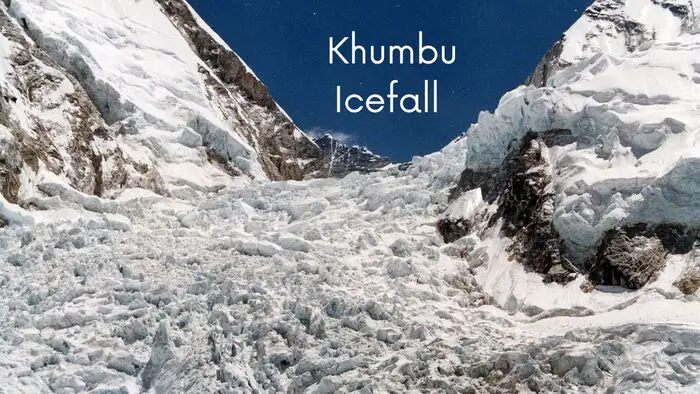Situated in the breathtaking Khumbu Valley, this icy paradise has captivated mountaineers worldwide, enchanting them with its mesmerizing beauty and allure. The Khumbu Icefall, a dangerous section of the Khumbu Glacier, stretches for approximately 5 kilometers, constantly in motion as if it were living. Its significance lies not only in its geological wonders but also in the crucial role it plays for those who summit Mount Everest.
When someone asks just how difficult is it to climb Everest, one of the first things that pops into climbers’ minds is the Khumbu Icefall. With its iconic network of ladders and ropes suspended over vast crevasses. All which represent a thrilling and heart-stopping chapter in the climbers’ narrative, testing their courage and skill as they navigate the icy chasms.
However, the Khumbu Icefall’s reputation is tinged with a somber reality. Its unforgiving nature has claimed numerous lives throughout history, reminding us of the immense risks faced by several climbers. The path through this icy maze demands respect, careful planning, and a profound understanding of the mountain’s temperament.
Let’s take a deeper look at the Khumbu Icefall, and how the dangers of the section contributes to Everest being one of the top 10 dangerous mountains to climb.
What is the Khumbu Icefall?
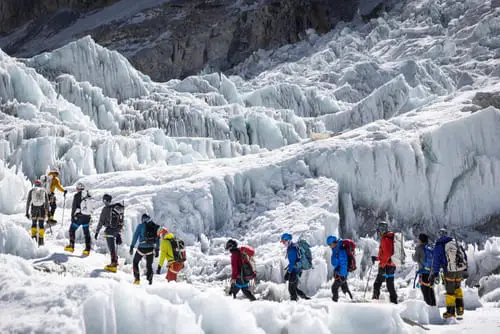
The Khumbu Icefall is a part of the Khumbu Glacier, which is located in the Khumbu Valley. It’s a long stretch of ice that constantly moves for about 5 kilometers. The Khumbu Icefall is also famous for its special ladders that help climbers move across large gaps in the ice called crevasses.
Unfortunately, it is very dangerous to pass through the icefall, and many lives have been lost in the process. The icefall itself measures 1.62 miles (2.3 kilometers) in length, and is one of the most dangerous sections of climb to summit Everest.
Exploring the Dynamic Path of the Khumbu Glacier:
The Khumbu Glacier near Mount Everest, moves around 0.9 to 1.2 meters (3 to 4 feet) down the mountain each day. It takes about 4.3 years for the ice to travel from the upper part of the glacier to the bottom, which is around 2,000 feet lower and about a mile away. The combination of the glacier’s speed and the steep drop in elevation creates a section called a bergschrund, which is like a shoulder of ice. At the top of this section, there are large blocks of ice that break off from the upper glacier, forming deep crevasses that are often over 50 feet wide and hundreds of feet deep.
As these massive ice segments move down the bergschrund, they become twisted and crushed by the pressure of the moving glacier. This causes the middle part of the bergschrund to have a complex network of crevasses, making it very difficult to navigate. Towards the bottom, there is a chaotic arrangement of smaller ice blocks, creating a maze-like structure.
Because the glacier is always moving, there are hidden cracks or crevasses and big blocks of ice called seracs that hang overhead. These seracs can weigh from several tons to thousands of tons. They can suddenly break or collapse, causing a serious threat. If a climber gets caught in an avalanche or any other sudden movement in the icefall, it’s difficult for them to escape without getting hurt. The landscape of the icefall makes it hard to move quickly and avoid danger.
Even though expert guides have set up ropes and ladders to help climbers cross the Khumbu Icefall, it is still incredibly risky. Unfortunately, this has resulted in 47 fatalities despite these safety measures.
Evolution of Conquering the Khumbu Icefall:
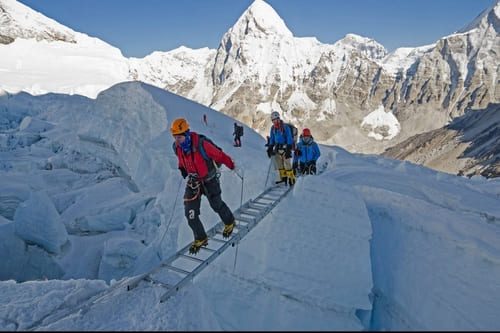
In the early 1920s, while George Mallory was searching for a way to climb Mount Everest, he came across the Khumbu Icefall. He described it as extremely steep and broken, making it a challenging obstacle. Mallory believed that approaching the mountain from Tibet was comparatively easier, so he shifted his focus in that direction.
It wasn’t until 1950 that the Khumbu Icefall became a possibility for climbers. Charlie Houston and Bill Tilman led a British team to Nepal to explore potential routes, and considered that it might be feasible to navigate the icefall.
In 1951, another British team led by Eric Shipton attempted to climb through the icefall but had to stop just before reaching the top due to a wide crevasse. During these early expeditions, climbers used long tree trunks as makeshift ladders when they ran out of proper equipment.
In 1952, a Swiss team overcame this obstacle by entering the crevasse and crossing a precarious snow bridge. They managed to reach an altitude of 8,500 meters using the Southeast Ridge route, which is the same route used by John Hunt and his successful British expedition in 1953, resulting in the first summit of Mount Everest.
Why is the Khumbu Icefall Dangerous?
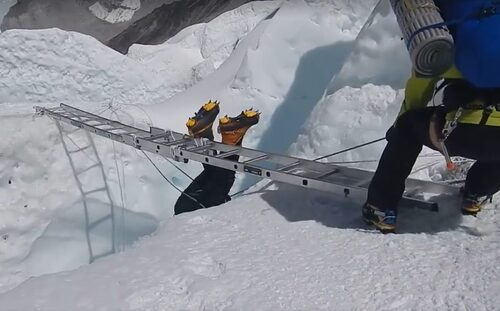
The Khumbu Icefall is filled with various dangers that have tragically claimed many lives. According to the Himalayan Database, there have been a total of 47 recorded deaths in the Icefall from 1953 to 2023. The most recent data includes three deaths that occurred in 2023.
The 47 deaths can be categorized as follows:
1. Falling into a crevasse:
Falling into a crevasse is a common danger when climbing Everest. Climbers are usually connected to a fixed rope at all times while moving through the Icefall. This is done to ensure that if they accidentally step on a weak snow bridge or slip off a ladder, the rope will catch them and prevent them from falling into the crevasse. However, many incidents of falling into crevasses occur when climbers are not properly connected to the rope.
2. Collapses within sections of the Icefall:
Another hazard in the Icefall is the risk of being hit by collapsing ice structures. The Icefall contains tall seracs, which can fall over as the Icefall shifts or an entire section of the Icefall can collapse suddenly without warning. Although this event is not very common, it can be extremely dangerous and can even result in the climber’s death on Everest.
A tragic example occurred in 1972 when an Australian climber, who was part of Chris Bonington’s British Everest SW Face Expedition, went into the Icefall but was never seen again. A search team later discovered a large area of the Icefall that had collapsed, and it was assumed that the climber was in that area when the collapse happened. In 2008, his body was found at the bottom of the Khumbu Icefall.
3. Avalanches onto the Icefall:
Avalanches caused by ice falling from the West Shoulder of Everest have resulted in significant casualties and are considered one of the most dangerous threats in recent times. There have been two major incidents. In 1970, six Sherpas were killed while supporting a Japanese expedition, and in 2014, one of the deadliest days in Everest’s history, 16 Sherpas lost their lives on April 18. The tragedy occurred when a large piece of hanging ice, known as a serac, broke free while the Sherpas were waiting for a ladder to be replaced over a crevasse while transporting supplies to higher camps.
These statistics highlight the grave risks associated with navigating the Khumbu Icefall, emphasizing the need for caution and preparedness when attempting to conquer this treacherous section of Mount Everest.
The 2014 Everest Ice Avalanche
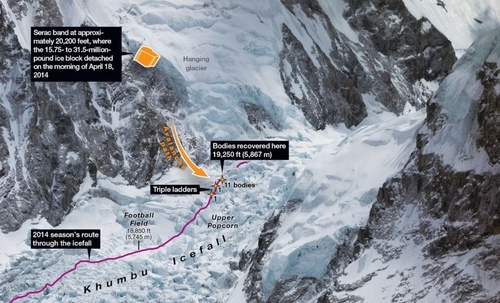
On April 18, 2014, seracs on the side of Mount Everest broke apart, causing a large amount of ice to come crashing down in an avalanche. This tragic event happened in the Khumbu Icefall and resulted in the deaths of sixteen Sherpas who were climbing in that area.
It is important to note that this was the same location where the Mount Everest disaster of 1970 had occurred. Thirteen of the bodies were found and brought back within two days, while the remaining three were not recovered because of the dangers associated with a rescue mission.
Navigating the Hazardous Khumbu Icefall:
A team of skilled Sherpas known as the Icefall Doctors is responsible for creating and maintaining the route through the Icefall up to Camp 2. After the tragic accident in 2014, experienced climbers gathered to discuss changing the route through the Icefall.
In recent years, the route had been shifted more towards the West Shoulder because it was quicker for the Icefall Doctors to establish. However, this posed a clear danger with a large ice formation hanging overhead. Upon reviewing old maps and photographs, veteran climbers Pete Athens and David Breashears suggested returning to the route used in the 1950s, which would take the path closer to Nuptse.
In 2015, the Icefall Doctors implemented this change, making the route shorter and safer. Although the route was not fully tested that year due to an early end to the season caused by an earthquake, it was used again in 2016 with positive outcomes, despite some sections being steep and challenging.
Safety Tips for Climbing The Khumbu Icefall:

The safest method to cross the icefall is by starting the journey from Everest Base Camp during the nighttime and traveling through it in darkness. This approach is preferable because the temperature is colder, resulting in less movement of the ice.
Typically, it takes approximately 6 hours to complete the crossing of the icefall. However, slower climbers may take up to 12 hours, while experienced Sherpas can accomplish it in as little as 2 to 3 hours.
Common precautions that climbers take to protect themselves:
- Avoid being in the Icefall when the sun heats up the ice, causing it to move.
- Always stay connected to the fixed rope, even while crossing ladders.
- Limit stops to just a few minutes at any spot in the Icefall.
- Move as quickly as you can while maintaining safety.
- Allow faster climbers to pass.
However, it’s important to note that even with these precautions, unexpected events can still occur. The 2014 serac collapse happened before the sun reached the Khumbu Icefall, around 6:45 am, while the ice is usually affected by the sun around 10:00 am.
Additionally, the ice screws that secure the fixed ropes can melt, reducing the safety provided by the ropes. Therefore, the best approach is to move fast, be confident, and possess extensive experience in climbing with crampons on steep snow and ice. The more experience you have, the safer you will be.
Can You Avoid The Khumbu Icefall?
Mount Everest can be climbed from two sides: Nepal and Tibet. If you choose to climb from the Nepal side, you will have to face the challenging Khumbu Icefall. Many attempts have been made over the years to find an alternative route, but so far, none have been successful.
On the other hand, if you decide to climb from Tibet, you can avoid the Khumbu Icefall. However, the remaining part of the climb from the Tibet side is more technically demanding, difficult, and dangerous. Even though the death rate for climbing Everest is slightly lower from the Nepal side (3.7%) compared to the Tibet side (3.8%), it is important to note that neither route can be considered significantly safer than the other.
Therefore, climbing Mount Everest from the Tibet side does eliminate the challenge of the Khumbu Icefall, but the overall risks and difficulties of the climb remain comparable to those on the Nepal side.
Is the Khumbu Icefall Melting?
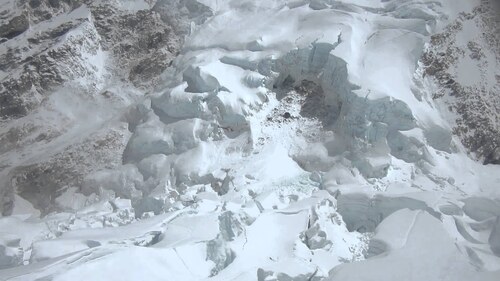
According to a report by ICIMOD in May 2023, in the past sixty years, the 79 glaciers encircling Mount Everest have become significantly thinner, losing more than 100 meters of ice. The rate at which they are thinning has nearly doubled since 2009.
One of these glaciers is the famous Khumbu Glacier, where many expeditions, including the historic journey of Hillary and Tenzing Norgay, began several decades ago. Scientists warn that the Khumbu Glacier is dangerously close to disappearing or shrinking significantly due to the effects of climate change.
Scientists have observed changes in the Khumbu Icefall over the years. The warmer temperatures are causing the ice to melt at a faster rate than in the past. This melting has consequences for the stability of the icefall, as it can lead to the formation of deep crevasses and the collapse of ice structures. The retreat of the Khumbu Glacier, of which the icefall is a part, is also a clear indication of melting.
The melting of the Khumbu Icefall also has significant implications for climbers attempting to summit Mount Everest. The icefall becomes more hazardous as the melting increases, with a higher risk of avalanches and ice collapses. The changing dynamics of the icefall make navigation more challenging and increase the dangers associated with crossing it.
Efforts are being made to monitor and understand the changes taking place in the Khumbu Icefall and the surrounding glaciers. Scientists and mountaineers alike recognize the need for sustainable practices and climate action to mitigate the effects of global warming and protect these magnificent natural wonders for future generations.
FAQs: Khumbu Icefall
Here are the most frequently asked questions about the Khumbu Icefall:
Crossing the Khumbu Icefall is extremely hazardous, despite the efforts of professional guides who have installed extensive rope and ladder networks. Unfortunately, these safety measures have not been able to prevent loss of life. According to the official Himalayan Database, there have been 44 recorded deaths in the icefall between 1953 and 2016.
From 1953 to 2023, a total of 47 deaths have been recorded in the Khumbu Icefall. The latest data reveals that in 2023 alone, there were 3 unfortunate fatalities in this area.
The Khumbu Icefall is the most risky section of an Everest expedition, despite efforts to make it safer. Although some dangers are visible and can be avoided, there is a risk of hidden crevasses under snow bridges. Even with the installation of ropes and ladders by the ice doctors each climbing season, caution is necessary due to the inherent dangers of the Khumbu Icefall.
The Khumbu Icefall acts as a channel, directing debris and ice from the Western Cwm downward towards the Khumbu Glacier, located 1,000 meters below.
